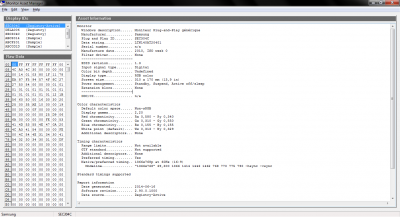#Maintained by: RehabMan for: Laptop Patches
#graphics_EDID.txt
#
# Use this patch generic patch with EDID capability
# if your display seems to exhibit EDID problems.
#
# Inject HDMI info and dual-link into GFX0/IGPU
into method label _DSM parent_adr 0x00020000 remove_entry;
into device name_adr 0x00020000 insert
begin
Method (_DSM, 4, NotSerialized)\n
{\n
If (LEqual (Arg2, Zero)) { Return (Buffer() { 0x03 } ) }\n
Return (Package()\n
{\n
//IMPORTANT: edit for actual snb-platform-id\n
"AAPL,snb-platform-id", Buffer() { 0x00, 0x00, 0x01, 0x00 },\n
//IMPORTANT: edit for actual ig-platform-id\n
"AAPL,ig-platform-id", Buffer() { 0x04, 0x00, 0x66, 0x01 },\n
//IMPORTANT: remove this line if not dual-link\n
"AAPL00,DualLink", Buffer() { 0x01, 0x00, 0x00, 0x00 },\n
//for HDMI-audio\n
"hda-gfx", Buffer() { "onboard-1" },\n
//EDID section: Fill in with your actual 128 bytes of EDID data\n
//Note: Clover uses override-no-connect, but I've also seen\n
// override-no-edid. Not sure what the difference is.\n
//"AAPL00,override-no-connect", Buffer (0x80)\n
"AAPL00,override-no-edid", Buffer (0x80)\n
{\n
0x00, 0xff, 0xff, 0xff, 0xff, 0xff, 0xff, 0x00, 0x4c, 0xa3, 0x4c, 0x30,\n
0x00, 0x00, 0x00, 0x00, 0x00, 0x14, 0x01, 0x03, 0x80, 0x1d, 0x11, 0x78,\n
0xea, 0x87, 0xf5, 0x94, 0x57, 0x4f, 0x8c, 0x27, 0x27, 0x50, 0x54, 0x00,\n
0x00, 0x00, 0x01, 0x01, 0x01, 0x01, 0x01, 0x01, 0x01, 0x01, 0x01, 0x01,\n
0x01, 0x01, 0x01, 0x01, 0x01, 0x01, 0x12, 0x1b, 0x56, 0x60, 0x50, 0x00,\n
0x16, 0x30, 0x30, 0x20, 0x25, 0x00, 0x35, 0xae, 0x10, 0x00, 0x00, 0x19,\n
0x00, 0x00, 0x00, 0x0f, 0x00, 0x00, 0x00, 0x00, 0x00, 0x00, 0x00, 0x00,\n
0x00, 0x25, 0xd9, 0x06, 0x6a, 0x00, 0x00, 0x00, 0x00, 0xfe, 0x00, 0x53,\n
0x41, 0x4d, 0x53, 0x55, 0x4e, 0x47, 0x0a, 0x20, 0x4c, 0xa3, 0x41, 0x54,\n
0x00, 0x00, 0x00, 0xfe, 0x00, 0x4c, 0x54, 0x4e, 0x31, 0x34, 0x30, 0x41,\n
0x54, 0x32, 0x30, 0x34, 0x30, 0x31, 0x00, 0xdf\n
},\n
})\n
}\n
end;

